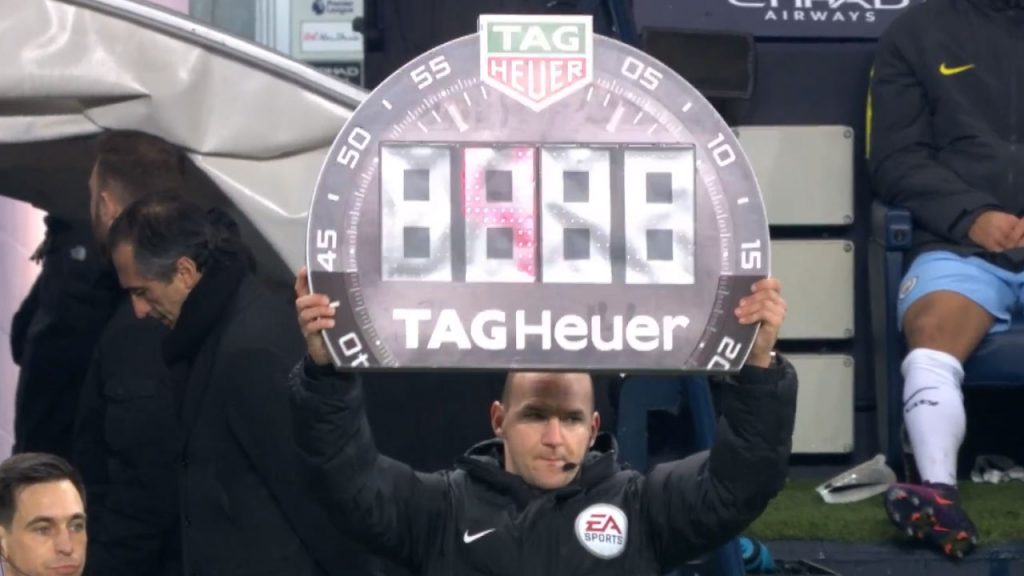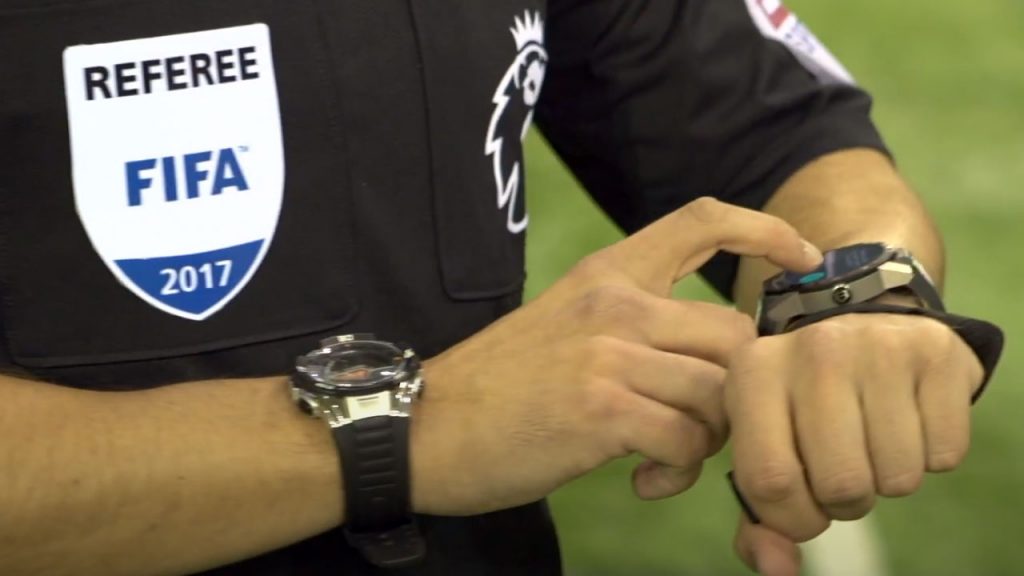Authority Soccer (authoritysoccer.com) is a participant in the Amazon Services LLC Associates Program, an affiliate advertising program designed to provide a means for sites to earn advertising fees by advertising and linking to Amazon.com. This site also participates in other affiliate programs and is compensated for referring traffic and business to them.
We have seen it many times in soccer, a team’s coach and their staff yelling from the bench, “Time, ref!” “It is over!” “We are in full time already!”.
Generally, the winning team makes the call, or the team gets benefits from the current result. But why do the coaches do that? What does full-time mean in soccer?
FIFA rules establish that a soccer match is played in two halves of 45 minutes. The official length for a soccer game is 90 minutes to full time. They can last less time in some cases, like when the teams restart a suspended game.
There is some confusion about the total time in soccer games. The rule says that the matches must have 90 minutes of the game in total.
But then there are stoppages, substitutions, arguments after a foul, players writhing in pain on the floor, and those interruptions should be added as injury time at the end of each half.
What does full-time mean in soccer?
When we talk about full time, we refer to the 90 minutes the rules say a soccer game should last.
But there is always added time at the end of the halves; that is why some coaches say that their players must be alert during “the 95 minutes the game lasts.”
Many coaches in modern soccer are training their teams to compete for 95 or 100 minutes.
Still, there is controversy about the added time. After almost every game, coaches discuss how much time was lost and how much the ref added afterward.
If we stick to the rules, FIFA contemplates seven situations in which the time wasted by players or lost by the circumstances should be added at the end of that half.
- Substitutions – Any player substitution made during a stoppage of the game.
- Assessment/ Removal of injured players – The time lost waiting for the medical team to reach the injured player, and the time spent in removing them from the field.
- Wasting time – A player who deliberately delays the restart of the game after a throw-in, a corner kick, a goal kick, or a free=kick.
- Disciplinary sanction – The time spent when a player is shown a yellow or a red car. Discipling the players usually doesn’t take much time; the arguments are time-consuming after the cards are revealed.
- Medical stoppages – These stoppages were created for matches played in scorching weather, where the players need to stop to cool down a bit and drink some water. Ideally, games in this weather should be avoided, but in some regions at a particular time of the year is impossible to do so.
- VAR checks and reviews – This allowance of time is new, and it is the most controversial. Soccer leagues and officials are still getting used to VAR technology, and sometimes revisions take forever to reach a decision. The sensation is that the time stopped for VAR reviews is never added entirely when regular time ends.
- Other delays not contemplated above – The rules try to cover every possible aspect of time delay. Other delays include goal celebrations, arguments with the coaches, and so forth.
The rule also states that if the referee committed a mistake when adding time at the end of the first half, they should not compensate in the second half.
This means that if the ref should have added 4 minutes to the first half and added 3, they should not add that extra minute to the second half.
How long is a full-time soccer match?

If we add the total time of the first and second half of any soccer match, the result will never be 90 minutes. Full time, also referred to as FT, will always be more.
As we mentioned above, the minutes added to the full time try to compensate for the stoppages; still, the teams have a licit resource to delay the game without paying the price in minutes after the 90 minutes: fouls and balls out of the pitch.
The data is interesting because it surges from soccer specialists’ observations regarding what is called in soccer “effective time.”
As soccer is a sport that doesn’t use the stopwatch, when the ball goes out or a foul is committed, the clock keeps ticking. The ref will compensate for the time a player stays on the floor pretending to be injured, but they won’t compensate for the time wasted in regular fouls.
The same happens with throw-ins and corner kicks. That’s why the ball boys hurry up to return the ball when their team loses.
Effective time studies in the major European leagues stated that matches have less than 70 minutes of the ball in-game; the rest of it goes in throw-ins, corner kicks, free kicks, offsides, and so forth.
There is a thin line between delaying the game and letting the time run. Some coaches ask their players to slow the game’s restart every time they can without getting reprimanded by the ref. The sanction for deliberately delaying the game is a yellow card.
But there are also other techniques to break the effective time in a soccer match without risking sanctions. One of them is throw-ins. For more efficiency, the ball should be kicked very far when sending it to a throw-in.
When teams abuse this resource, games can have an alarming total of 40 minutes of effective time. That is less than half of the FT.
Soccer has tricks old as the sport itself, like substitutions to waste time, ball boys delaying the ball when the home team is winning, or hiding the extra soccer balls in the field.
This last one is a South American classic. Whenever there is a final, if the home team is winning, the game is played with one ball; there are no reserve balls outside of the field. The ball boys look at each other, and they can’t imagine where the rest of the soccer balls could be.
There is also the issue of players wasting time during the extra minutes added to compensate.
These kinds of tricks are widespread in South America. Not even the arrival of VAR to the Copa Libertadores and Copa Sudamericana could change this yet.
Players still have many of these unsportsmanlike behaviors, and the referees either ignored them or accepted them as part of regional folklore.
All these tricks are part of the sport’s folklore. They were born with the game, and they seem inseparable from it.
FIFA suggests referees add thirty seconds for each regular substitution and a minute for every stretched entrance, but most of the referees end up not following these suggestions.
The logical solution to this problem seems to be using a stopwatch in soccer games, but I honestly don’t see that happening very soon. That will transform the sport into a different game.
Why do soccer games go over 90 minutes?

Soccer games end up lasting more than 90 minutes to compensate for the wasted time during the game. Which is, as we saw above, not enough.
A few minutes before full time, the ref communicates to the fourth official how many minutes of added time that match will have. The official will then raise the electric sign indicating how many minutes of injury time the teams must play.
The added time must contemplate the number of minutes the game was stopped due to unnecessary time-wasting behavior.
For some reason, referees never add the time they should. It is usual to watch soccer games where there are multiple substitutions, VAR reviews, arguments, and more, and the ref adds three or four minutes, while the added time should be way superior than that.
When the game is interrupted by a brawl or people invading the field, the official clock keeps ticking. The time wasted is added, like what happened in the 2020 Copa Libertadores match between the Brazilians Internacional and Gremio.
The game was played beyond the 105th minute due to an enormous brawl.
Does full time include extra time?

No, full-time in soccer refers to the stipulated 90 minutes a match should last. Any additional time played after that is either added or injury time, or extra time, which is totally different. Extra time in soccer is played in two halves of 15 minutes.
The extra time rule is almost as old as soccer itself, although it started to be used many years after its creation.
In 1922, in Germany, Hamburg and Nuremberg ended the final game tied 2-2 after 90 minutes. After that, they played 99 minutes more of “first to score wins.” Yes, 99 minutes, and no, nobody scored after that.
The natural tie-breaker in soccer is the penalty shootouts. The old-school MLS tried to impose the shootouts with zero acceptance from the soccer community.
But before penalties, if two teams remain tied after the 90 minutes and the extra 30 minutes, the winning team was decided in a coin toss.
Statistics say that ten of the last 15 games that ended tied after 90 minutes, didn’t score in the extra time, and ended up deciding their luck in a penalty shootout. But no one likes ties; they are not good for the business. Especially a 120 minutes 0-0 tie.
That is why someone had the idea of the golden goal.
The golden goal – An extra-time experiment

FIFA approved the golden goal rule in 1993. The golden goal is known in many sports as sudden death. It is basically the “next to score wins” rule. FIFA decided to name it “golden goal” because of sudden death’s negative connotation.
Three years after the rule was introduced to the sport, in 1996, the Euro was decided by a golden goal scored by the German Oliver Bierhoff. That was the first and only time a major tournament was decided by a golden goal.
Only four World Cup games were decided by a golden goal: one in France 1998, and three in Korea-Japan 2002. Three World Cups later, in 2004, FIFA agreed to abolish the golden goal rule, going back to the old extra-time and penalty shootout recipe.
But not before trying the golden goal’s son, the silver goal. The silver goal was basically the same as the golden, with the difference that if a team scored in the first extra time, the game will go until the end of that half and not finish immediately after the goal, like in the golden version.
The main idea behind the golden and silver goal was to incentivize the teams to be more aggressive and win the match. The intention behind it was noble, but the result was the opposite.
The success of a team when trying to score, in most cases, depends on the number of players they use to attack. The more players in offensive positions, the bigger the chances of scoring. But, more players attacking means also less playing defending.
Therefore, a team in attacking mode is much more vulnerable than a team defending. Sometimes the fear of conceding is more significant than the audacity to try and score. After all, it is instinctive, the self-preservation reflex.
Usually, teams will not risk losing a tournament at the last minute; they prefer betting in the penalties lottery. During a World Cup, squads speculate even more than in any tournament; that is why neither the golden or silver goal rule succeeded.
But if we think about it, the golden rule matches soccer perfectly. In soccer, not always the better team wins. The gods of soccer are usually unfair to the better team. There are dozens of examples of squads that were the best in a tournament that the other team won.
Perhaps if more games were as exciting as the 1982 World Cup’s semi-final in Spain between Germany and France, the golden goal would have never existed.
The 90 minutes ended 1-1 with two goals scored in the first half. In extra time, France scored twice in the first half of the extra time. The German’s fate looked decided. But Roumenigge scored for the Germans before the end of the first half of extra time.
Germany scored again in the second half of extra time and won the game on penalties.
Scoring a goal doesn’t mean the scoring team is better; it only means that they scored. The Czech keeper Petr Kouba, the goalkeeper that lost the Euro with the Bierhoff golden goal in 1996, said that it was devastating losing a game like that.
Even if their team is not playing very well, the soccer player always feels that they can tie and even win a game after the other team scores.
How long is the break between full-time and extra time in soccer?

After the 90 minutes game, the break between FT and extra time should not be superior to 15 minutes. It can be less if the competition establishes it.
Before starting, every competition must inform the participant teams of the length of the break between full and extra time.
After completing the 90 minutes, the teams cannot go to the locker rooms; they must stay on the field. This is to avoid another old soccer trick, delaying the players’ return to the pitch after half-time.
The difference between the full time and extra time half-time stoppage is that in the first one, the players have a 15-minute break, while in the second one, the players must immediately change sides and keep playing.
That is why extra times are physically and mentally exhausting. Even though the golden and silver goal rule is extinct, the pressure of playing extra time is massive.
Soccer players know that they have 30 extra minutes guaranteed after a tie, but still, the player feels overwhelmed because they didn’t complete the task they were supposed to in 90 minutes. It kinda feels like they already lost.
Coaches prepare their teams to compete for 90 or 95 minutes giving their best, without thinking in extra time.
That is why some coaches don’t practice penalty shootouts before an elimination game; they don’t want to plant the seed of the penalties in their players’ minds.
The tension augments because players know that there are many last-minute goals scored in every major tournament. The last ten minutes of extra time are perhaps more stressful than an entire penalty shootout round.
The hardest part of playing extra time is finding the balance between attacking to score and win, not neglecting the defense, and not getting exhausted.
When the body is tired, the mind can’t think clearly, and lots of mistakes are committed. This is valid not only for the defenders but also for the forwards. And nothing is more frustrating than missing a clear goal chance to seal the game.
There are techniques athletes can learn to manage their energy and recover themselves while not participating directly in the game’s actions. Soccer players can learn to lower their heart rate through breathing.
Players must use these techniques to perform better, especially during extra time, where their energy is at the lowest point.

